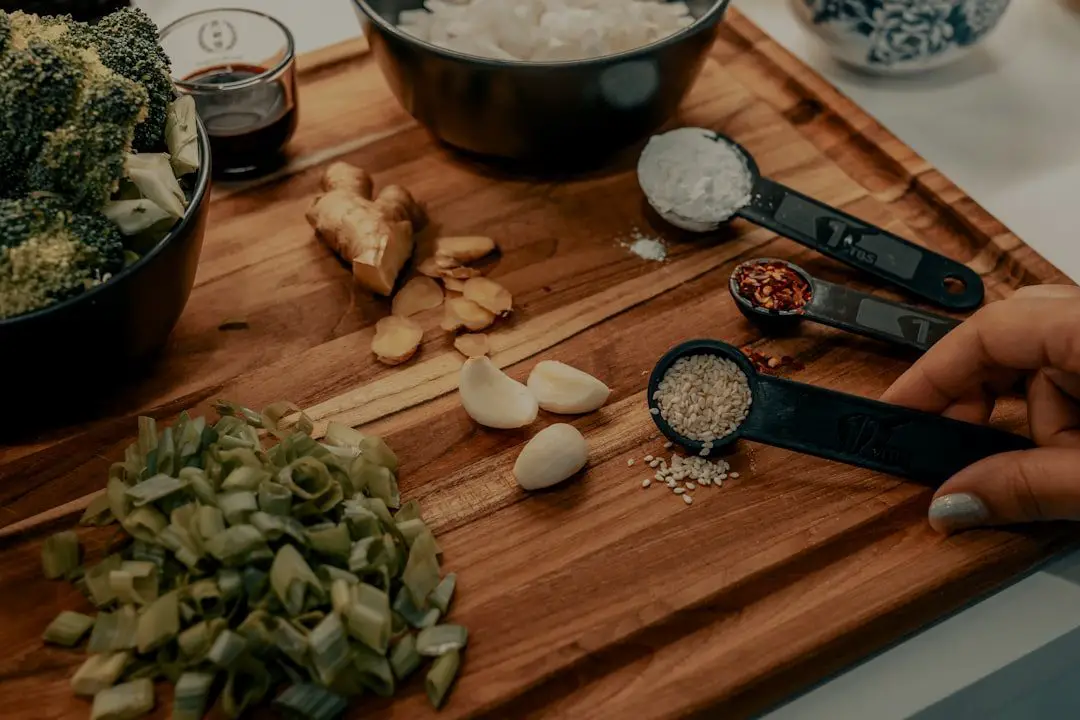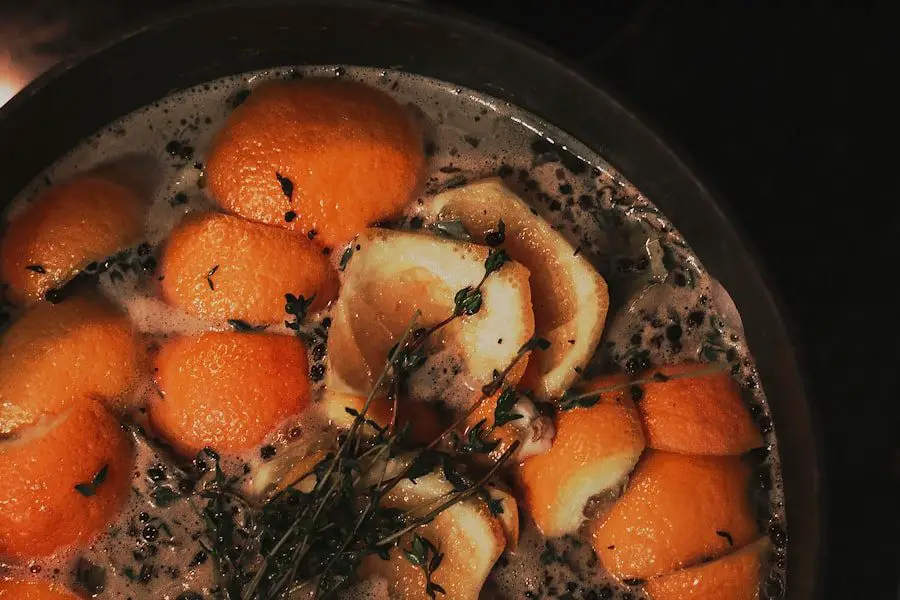
Seasonings are ingredients that are used to enhance the flavor of food. They can be herbs, spices, or blends of both, and they play a crucial role in cooking. Seasonings not only add taste to dishes but also bring out the natural flavors of the ingredients used. They can transform a simple meal into a culinary masterpiece.
Using seasonings in cooking is important because they add depth and complexity to dishes. They can elevate the flavor of even the most basic ingredients, turning a bland meal into something delicious and satisfying. Seasonings also allow for creativity in the kitchen, as they can be combined in different ways to create unique flavor profiles.
Seasonings can enhance the flavor of food in various ways. They can add heat and spice, such as with chili powder or cayenne pepper. They can provide a savory and umami taste, like with soy sauce or mushrooms. They can also add sweetness, sourness, or bitterness, depending on the seasoning used. By using seasonings, chefs and home cooks can create a balance of flavors that make each bite enjoyable.
Key Takeaways
- Seasonings are important because they add flavor and depth to dishes.
- Choosing the right meat for seasoning is crucial for achieving the desired taste.
- Understanding flavor profiles helps in creating balanced and delicious dishes.
- Classic seasoning blends from different cuisines can add variety to your cooking.
- Making your own spice blends allows you to customize flavors to your liking.
The Importance of Choosing the Right Meat for Seasoning
Different meats require different seasonings to bring out their best flavors. For example, beef pairs well with bold and robust seasonings like garlic, rosemary, and black pepper. On the other hand, chicken is more versatile and can be seasoned with a wide range of flavors, from citrusy herbs like thyme and lemon to spicy blends like jerk seasoning.
When choosing the right meat for a specific seasoning, it’s important to consider the flavor profile of both the meat and the seasoning. For example, if you’re using a sweet and tangy barbecue sauce, it would pair well with pork ribs or chicken wings. However, it may not work as well with beef steak, which has a stronger flavor that could overpower the sauce.
To avoid over-seasoning or under-seasoning meat, it’s important to taste as you go. Start with a small amount of seasoning and gradually add more until you achieve the desired flavor. Remember that it’s easier to add more seasoning than to remove it, so it’s better to start with less and adjust as needed.
Understanding Flavor Profiles: Sweet, Salty, Sour, Bitter, and Umami
Flavor profiles refer to the different tastes that can be detected in food. The five basic flavor profiles are sweet, salty, sour, bitter, and umami.
Sweet flavors are often associated with sugar and can be found in fruits, honey, and desserts. Salty flavors come from salt and can enhance the taste of savory dishes. Sour flavors are found in citrus fruits, vinegar, and fermented foods like pickles. Bitter flavors can be found in coffee, dark chocolate, and certain vegetables like kale and arugula. Umami is a savory taste that is often described as meaty or brothy and can be found in ingredients like mushrooms, soy sauce, and Parmesan cheese.
Balancing flavor profiles is important in cooking to create a well-rounded and enjoyable dish. For example, if a dish is too sweet, adding a touch of salt or acidity can help balance out the flavors. Similarly, if a dish is too salty or bitter, adding sweetness or umami can help mellow out the taste.
Examples of foods that fall under each flavor profile include:
– Sweet: strawberries, chocolate, honey
– Salty: bacon, soy sauce, olives
– Sour: lemons, vinegar, yogurt
– Bitter: coffee, dark chocolate, kale
– Umami: mushrooms, Parmesan cheese, miso paste
Classic Seasoning Blends: From Italian to Cajun to Mexican
| Seasoning Blend | Origin | Ingredients | Spice Level |
|---|---|---|---|
| Italian Seasoning | Italy | Thyme, oregano, basil, rosemary, sage | Mild |
| Cajun Seasoning | United States | Paprika, cayenne pepper, garlic powder, onion powder, thyme | Medium |
| Mexican Seasoning | Mexico | Cumin, chili powder, garlic powder, onion powder, oregano | Medium |
There are many classic seasoning blends that are used in various cuisines around the world. These blends are often a combination of herbs, spices, and sometimes other ingredients like salt or sugar. They can add depth and complexity to dishes and are a great way to add flavor without having to measure out individual spices.
Some popular seasoning blends include:
– Italian seasoning: a blend of dried herbs like basil, oregano, thyme, and rosemary. It is commonly used in Italian dishes like pasta sauces, pizzas, and roasted vegetables.
– Cajun seasoning: a spicy blend of paprika, cayenne pepper, garlic powder, onion powder, and other spices. It is commonly used in Cajun and Creole dishes like jambalaya, gumbo, and blackened fish.
– Mexican seasoning: a blend of chili powder, cumin, oregano, garlic powder, and other spices. It is commonly used in Mexican dishes like tacos, enchiladas, and chili.
– Indian curry powder: a blend of spices like turmeric, cumin, coriander, and ginger. It is commonly used in Indian dishes like curries, biryanis, and lentil soups.
These seasoning blends can be used in various ways in cooking. They can be added to marinades for meat or vegetables, sprinkled on top of roasted or grilled dishes, or used as a base for sauces and dressings.
Homemade Spice Mixes: How to Make Your Own Signature Blend
Making your own spice blends at home has many benefits. It allows you to customize the flavors to your liking and ensures that you know exactly what goes into your food. It also allows for creativity in the kitchen and can be a fun way to experiment with different flavors.
When creating a homemade spice blend, it’s important to consider the balance of flavors. Start with a base of herbs or spices that you enjoy and gradually add other ingredients until you achieve the desired taste. Taste as you go and adjust the seasoning as needed.
Here are a few examples of homemade spice blends:
– Mediterranean blend: a combination of dried herbs like oregano, thyme, rosemary, and basil. This blend is great for seasoning roasted vegetables, grilled meats, or even sprinkling on top of salads.
– BBQ rub: a blend of brown sugar, paprika, chili powder, garlic powder, onion powder, and other spices. This blend is perfect for seasoning ribs, chicken, or pork shoulder before grilling or smoking.
– Curry blend: a combination of spices like turmeric, cumin, coriander, ginger, and cinnamon. This blend can be used to make homemade curry sauces or to season roasted vegetables or grilled meats.
Using Fresh Herbs and Spices: Tips for Incorporating Them into Your Cooking

Fresh herbs and spices can add a burst of flavor to dishes and are a great way to elevate your cooking. They can be used in various ways, from adding a sprinkle of fresh herbs on top of a finished dish to using them as a base for marinades or dressings.
When using fresh herbs in cooking, it’s important to know how to handle them properly. Most herbs should be added towards the end of cooking to preserve their flavor. They can be chopped finely and added to sauces, soups, or stews. Some herbs like basil or cilantro can also be used as a garnish.
Fresh spices like ginger or garlic can be used in marinades or rubs to infuse flavor into meat or vegetables. They can also be used in stir-fries or sautés for added depth of flavor.
To store fresh herbs and spices, it’s best to keep them in the refrigerator wrapped in a damp paper towel or stored in an airtight container. Some herbs like basil can also be stored in water like a bouquet of flowers to keep them fresh for longer.
Examples of dishes that use fresh herbs and spices include:
– Caprese salad: a simple salad made with fresh tomatoes, mozzarella cheese, and basil leaves. It is often drizzled with olive oil and balsamic vinegar.
– Thai curry: a spicy and aromatic curry made with fresh herbs like lemongrass, Thai basil, and kaffir lime leaves. It is often served with rice or noodles.
– Garlic and herb roasted chicken: a flavorful chicken dish made with fresh garlic, rosemary, thyme, and lemon. It is often served with roasted vegetables or mashed potatoes.
Marinades and Rubs: Techniques for Infusing Flavor into Your Meat
Marinades and rubs are techniques used to infuse flavor into meat before cooking. They can be made with a combination of seasonings like herbs, spices, oils, acids, and other ingredients.
Marinades are liquid-based mixtures that are used to tenderize meat and add flavor. They can be made with ingredients like soy sauce, vinegar, citrus juice, olive oil, and various seasonings. The meat is soaked in the marinade for a period of time to allow the flavors to penetrate the meat.
Rubs, on the other hand, are dry mixtures that are rubbed onto the surface of the meat. They can be made with a combination of herbs, spices, salt, sugar, and other ingredients. The rub is applied to the meat before cooking and forms a flavorful crust as it cooks.
When creating a marinade or rub, it’s important to consider the balance of flavors. The marinade or rub should complement the natural flavors of the meat without overpowering it. Taste as you go and adjust the seasoning as needed.
Examples of marinades and rubs include:
– Teriyaki marinade: a mixture of soy sauce, ginger, garlic, honey, and other ingredients. It is commonly used to marinate chicken or beef before grilling or stir-frying.
– Dry rub for ribs: a blend of brown sugar, paprika, chili powder, garlic powder, onion powder, and other spices. It is commonly used to season pork ribs before grilling or smoking.
– Lemon and herb marinade: a mixture of lemon juice, olive oil, garlic, fresh herbs like rosemary and thyme, and other seasonings. It is commonly used to marinate chicken or fish before grilling or baking.
Grilling and Smoking: How to Use Seasonings to Enhance Your BBQ
Grilling and smoking are cooking techniques that can add a smoky and charred flavor to meat. Seasonings play an important role in enhancing the flavor of BBQ dishes and can be used in various ways.
When grilling meat, seasonings can be applied as a dry rub or as a marinade. The dry rub is applied directly onto the surface of the meat before grilling and forms a flavorful crust as it cooks. The marinade is used to tenderize the meat and add flavor.
When smoking meat, seasonings can be added to the wood chips or pellets used for smoking. This allows the flavors to infuse into the meat as it cooks. Seasonings can also be added to the water pan or drip pan to create steam and add moisture to the meat.
To create a flavorful BBQ, it’s important to choose the right seasonings that complement the type of meat being cooked. For example, a sweet and tangy barbecue sauce works well with pork ribs or chicken wings. A spicy dry rub pairs well with beef brisket or pork shoulder.
Examples of BBQ dishes that use seasonings include:
– Smoked ribs: pork ribs that are seasoned with a dry rub and smoked low and slow until tender. They are often served with barbecue sauce on the side.
– Grilled chicken: chicken pieces that are marinated in a flavorful marinade and grilled until cooked through. They can be served with a variety of sauces or dips.
– Smoked brisket: beef brisket that is seasoned with a dry rub and smoked for several hours until tender. It is often sliced and served with barbecue sauce or pickles.
Pairing Wine and Beer with Seasoned Meat: A Guide to Complementing Flavors
Pairing wine and beer with seasoned meat can enhance the dining experience by complementing the flavors of the dish. The right pairing can bring out the best in both the food and the beverage, creating a harmonious balance of flavors.
When choosing wine or beer to pair with seasoned meat, it’s important to consider the flavors of both the dish and the beverage. For example, a bold and robust red wine like Cabernet Sauvignon pairs well with a heavily seasoned steak, as the tannins in the wine can help cut through the richness of the meat.
Similarly, a hoppy and bitter IPA beer pairs well with spicy dishes like Cajun or Mexican cuisine, as the bitterness can help balance out the heat. A light and crisp white wine like Sauvignon Blanc pairs well with seafood dishes seasoned with herbs and citrus, as the acidity in the wine can complement the flavors.
When in doubt, it’s always a good idea to consult with a sommelier or beer expert who can provide guidance on pairing options. They can recommend specific wines or beers that will complement the flavors of your seasoned meat.
Examples of wine and beer pairings with seasoned meat include:
– Grilled steak with Cabernet Sauvignon: a juicy steak seasoned with a bold dry rub pairs well with a full-bodied red wine like Cabernet Sauvignon.
– Spicy Cajun shrimp with IPA beer: shrimp seasoned with Cajun spices pairs well with a hoppy and bitter IPA beer, as the bitterness can help balance out the heat.
– Herb-roasted chicken with Sauvignon Blanc: chicken seasoned with fresh herbs like rosemary and thyme pairs well with a crisp and acidic white wine like Sauvignon Blanc.
Healthy Seasoning Alternatives: Low-Sodium, Low-Fat, and All-Natural Options
For those looking for healthier seasoning alternatives, there are many options available that are low in sodium, low in fat, and made with all-natural ingredients. These alternatives can add flavor to dishes without compromising on taste or health.
Some healthy seasoning alternatives include:
– Herbs and spices: using fresh or dried herbs and spices is a great way to add flavor to dishes without adding extra sodium or fat. They can be used in various ways, from sprinkling them on top of finished dishes to using them as a base for marinades or rubs.
– Citrus juice and zest: citrus fruits like lemons, limes, and oranges can add a burst of flavor to dishes without adding extra calories or sodium. The juice can be used in marinades or dressings, while the zest can be used to add a bright and tangy flavor to dishes.
– Vinegars: vinegars like balsamic, apple cider, or rice vinegar can add acidity and depth of flavor to dishes without adding extra fat or sodium. They can be used in dressings, marinades, or even as a finishing touch on roasted vegetables or grilled meats.
– Homemade vinegars are also a great option for those who want to experiment with different flavors. By infusing fruits, herbs, or spices into a base vinegar, you can create unique and personalized blends that can elevate any dish. Additionally, making your own vinegar allows you to control the quality of ingredients and avoid any unnecessary additives or preservatives. Whether you choose to use store-bought or homemade vinegars, incorporating them into your cooking can enhance the taste and complexity of your meals.
If you’re a fan of meat seasonings, you’ll definitely want to check out this article on Flavorful Sips. They have a wide range of delicious recipes and tips for enhancing the flavors of your favorite meats. One article that caught my attention is their recipe for a refreshing sangria watermelon. It’s the perfect summer treat that combines the sweetness of watermelon with the tangy flavors of sangria. Trust me, it’s a must-try! You can find the recipe here.



